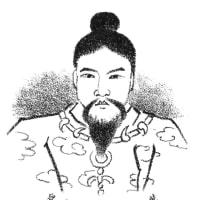『日本書紀』推古天皇 14
戊子、詔曰「朕聞之、曩者、我皇祖天皇等宰世也、跼天蹐地、敦禮神祗、周祠山川、幽通乾坤。是以、陰陽開和、造化共調。今當朕世、祭祠神祗、豈有怠乎。故、群臣共爲竭心、宜拜神祗。」甲午、皇太子及大臣、率百寮以祭拜神祗。
秋七月戊申朔庚戌、大禮小野臣妹子遣於大唐、以鞍作福利爲通事。是歲冬、於倭國作高市池・藤原池・肩岡池・菅原池、山背國掘大溝於栗隈、且河內國作戸苅池・依網池、亦毎國置屯倉。
十六年夏四月、小野臣妹子至自大唐。唐國號妹子臣曰蘇因高。卽大唐使人裴世淸・下客十二人、從妹子臣至於筑紫。遣難波吉士雄成、召大唐客裴世淸等。爲唐客更造新館於難波高麗館之上。
≪英訳≫
Tsuchinoe Ne(戊子)、The Emperor issued an edict, saying:
“I have heard that in ancient times, our imperial ancestors, the heavenly sovereigns, ruled the world with great care. They reverently honored and respected the deities (神祇 kamigami), held rituals for the spirits of the mountains and rivers, and maintained harmony between heaven and earth. As a result, the forces of yin and yang(陰陽) were balanced, and the workings of the gods proceeded smoothly. Now, in my reign, how could we neglect the worship of the gods? Therefore, let all my ministers (群臣) devote their utmost sincerity to worship and reverence for the gods.”
On the 15th day of the same month (甲午), the Crown Prince (皇太子 聖徳太子), the Grand Minister (大臣, ōomi), and all the court officials (百寮, momo no tsukasa) together conducted rituals to honor and worship the deities.
Autumn, 7th Month, 3rd Day (戊申)
The court dispatched Onono no Omi Imoko (小野臣妹子) as an envoy (大礼, dairai) to the Great Tang (大唐). Kuratsukuri no Fukuri (鞍作福利) served as his interpreter (通事).
Winter, same year, in the land of Yamato (倭国), several reservoirs were constructed: Takechi-no-ike (高市池), Fujiwara-no-ike (藤原池), Kataoka-no-ike (肩岡池), and Sugawara-no-ike (菅原池). In Yamashiro Province (山背国, Yamashiro no kuni), at Kurukuma (栗隈, in present-day Uji City, Nara Prefecture), a large water channel (大溝 ōuna) was dug. Additionally, in Kawachi Province (河内国), Tokari-no-ike (戸莉池) and Yosami-no-ike (依網池) were built. Furthermore, rice storage facilities (屯倉 miyake) were established in each province.
16th Year, Summer, 4th Month
Onono Imoko returned from the Great Tang(大唐). In the Tang court, Imoko was referred to as “Soin Kō” (蘇因高), a title derived from the characters for “Imo” (因) and “Ko” (高).
The Great Tang sent their envoy, Pei Shiqing (裴世清), along with 12 attendants (下客 shimobe), who accompanied Imoko to Tsukushi (筑紫 in present-day Kyushu). The court dispatched Naniwa no Kishi Onari (難波吉士雄成) to receive Pei Shiqing and his delegation.
To accommodate the Tang guests, a new residence (新館) was constructed near the Korean Residence (高麗館 Koma no Mutsuro) in Naniwa (難波, modern-day Osaka).
≪この英文の和訳≫
戊子 (みずのえね)、天皇は詔(みことのり)を発して次のように言われました。「朕(ちん)は聞いている。昔、我が皇祖(こうそ)である歴代の天皇方は、この世を慎重に治められた。その際、敬虔に神祇(かみがみ)を敬い、山川の神々を祀り、天地を通じて神々の心を調和させられた。それによって陰陽が和合し、神々の御業(みわざ)も順調に進んだのである。今、朕の代においても、神祇の祭祀を怠ることがあってはならない。ゆえに、群臣(くんしん 諸臣)は心を尽くし、神祇をよく拝するように努めるべきである」。
同月十五日(甲午 きのえうま)に、皇太子(聖徳太子)と大臣(おおおみ)は、百寮(もものつかさ)を率いて、神祇を祀り、拝された。
秋七月三日 (戊申 つちのえさる)
大礼(だいらい)として、小野臣妹子(おののおみ いもこ)を大唐に遣わされた。鞍作福利(くらつくりのふくり)が通事(通訳)を務めた。
同年冬、倭国(やまとのくに)において、高市池(たけちのいけ)、藤原池(ふじわらのいけ)、肩岡池(かたおかのいけ)、菅原池(すがわらのいけ)を造営した。また、山背国栗隈(やましろのくにくるくま、現奈良県宇治市)に大溝(おおうな 用水路)を掘り、河内国には戸莉池(とかりのいけ)と依網池(よさみのいけ)を築いた。さらに、国ごとに屯倉(みやけ 皇室の直轄倉庫)を設けた。
十六年夏四月、小野妹子(おののいもこ)が大唐から帰朝した。大唐においては、妹子のことを「蘇因高(そいんこう)」と呼び、その名は「妹=因」「子=高」という漢字の意味に由来するものであった。
大唐の使者である裴世清(はいせいせい)は、下客(しもべ)十二人とともに、小野妹子に従い筑紫(つくし 現福岡県)に到着した。難波吉士雄成(なにわのきしおなり)を遣わし、唐の客である裴世清らを迎えた。
さらに、唐の客人のために新しい館を難波(現大阪市)の高麗館(こまのむつろ)の近くに造営した。
令和7年1月2日(木) 2025













